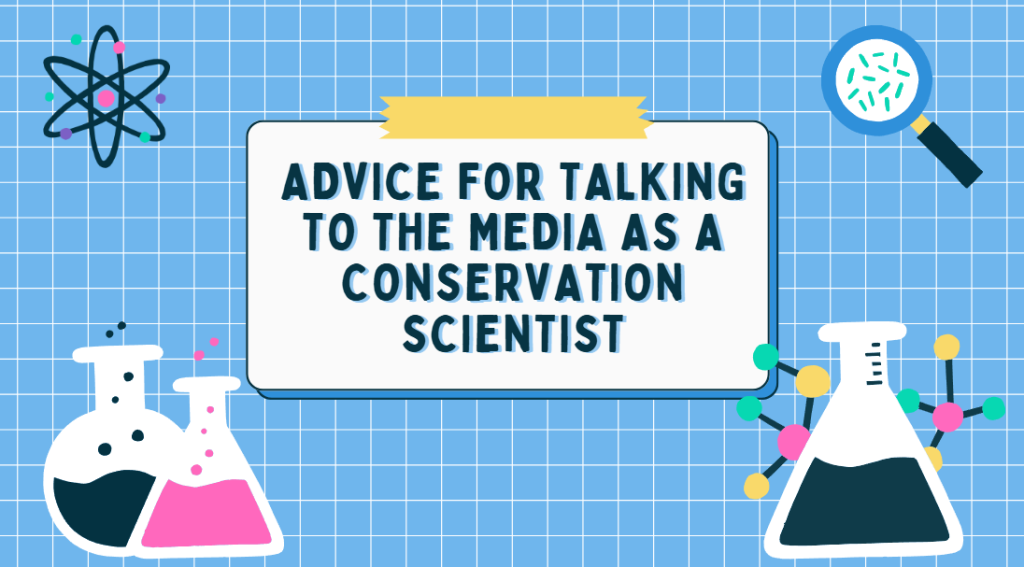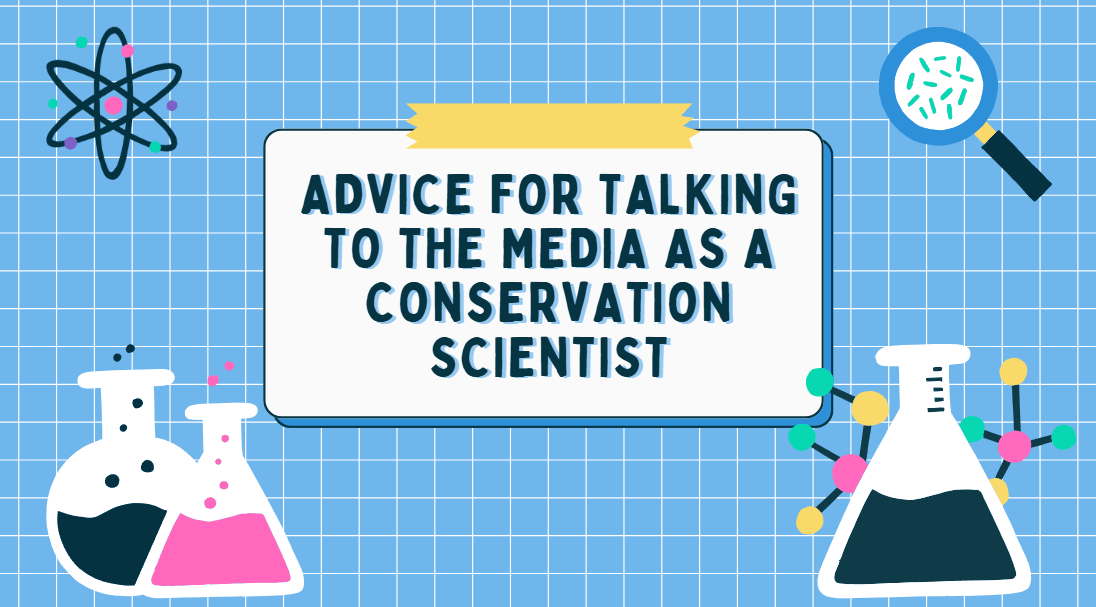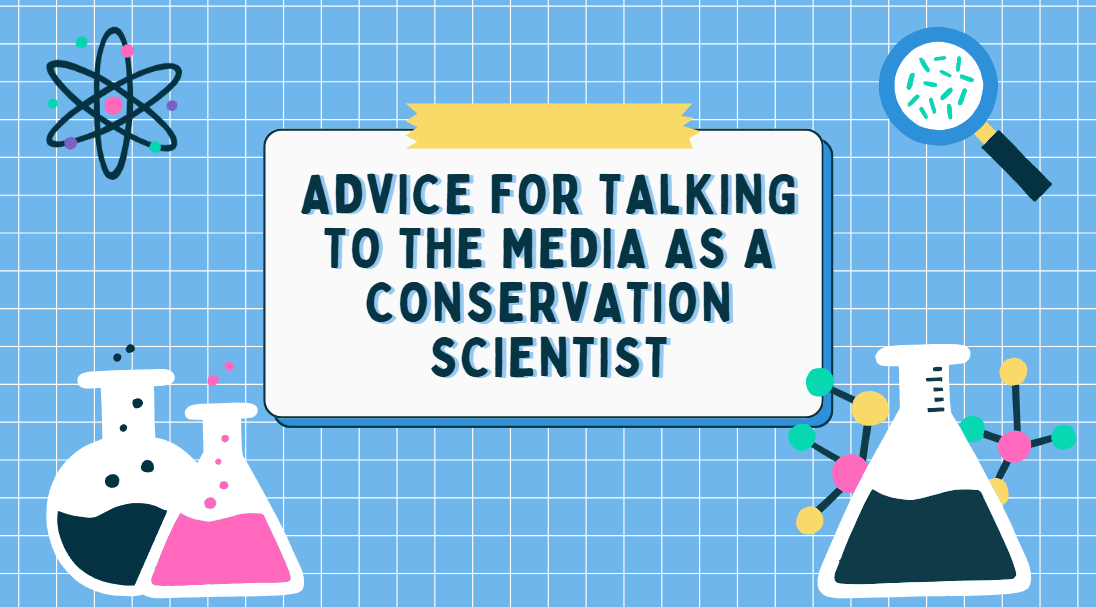
Many environmental scientists understand that there is value in communicating about their work through the media, as publicity can help raise public awareness of a conservation threat and help build support for a policy solution. Most training material focuses on how to craft and deliver effective messages. However, this is only part of the skillset required to be effective as a media-savvy science communicator. Despite recognizing how positive media coverage can help the environmental causes they care about, many scientists are leery of speaking with journalists about their areas of expertise, owing to concerns about possible bad experiences. Here, we argue that scientists have many tools available that can affect the likelihood of whether a given interaction goes well, or goes poorly. We articulate some basic differences between professional norms in journalism versus those of science, and provide specific advice and strategies that can maximize the likelihood of a positive outcome, and reduce potential for harm. Specific examples of how we’ve used these strategies in interviews about climate change and endangered species conservation are provided throughout. By more thoroughly understanding all sides of a scientist-journalist relationship and the associated science-media cycle, scientists will be in a better position to increase the chance that their work will have the conservation impact they intend.
This is part 3 of a series of blog posts on advice for conservation scientists to communicate with journalists about their areas of expertise. Part 1 focuses on key background about the science-media ecosystem and the roles and responsibilities of journalists. Part 2 focuses on mastering interviews themselves. This part focuses on a scientist’s role in writing a press release about their work, and subsequent parts will include tips for navigating the current science crisis in the United States. While our examples reference our careers as conservation scientists, the principles and tips discussed throughout are broadly applicable to scientists in many related disciplines.
Part 3: The press release and your role in it
A press release is a document summarizing the key findings and importance of your paper, usually written by a press officer or PIO at one of the papers’ coauthors’ institutions (de Semir et al. 1998). The goal is to entice a journalist to want to learn more about the paper, interview authors, and write about it themselves (Autzen 2014). It is important to note that these are essentially PR (public relations) documents whose goal is to make your work sound good and interesting (Woloshin and Schwartz 2002)
A press release will include some summary introducing your research questions, methods, and key conclusions. It will also include pre-written quotes from 2 or 3 authors, along with an explicit indication of which author or authors are available for interview if a journalist requests.
Sometimes a journalist will write about your research without ever speaking to you, using information and your provided quote from the press release. Additionally, some online media outlets simply reprint an entire press release word-for-word rather than do any original journalism or writing, a practice sometimes known derisively as “churnalism.” Therefore, it is important that you review the press release prior to distribution and that you are satisfied with your quote.
While experienced science communicators may play a more active role in writing the press releases for their work, typically you will be working with a press officer who will do the bulk of the writing. Keep in mind that these staffers are not experts in your particular field, which means that they can provide very useful feedback on whether or not you’re explaining something clearly and whether or not it is interesting. Further, at smaller universities, these individuals may have no STEM-related training or experience whatsoever.
Press officers may make factual or conceptual errors when writing about your work, and managing this relationship requires patience and constructive feedback. A good press officer knows the limits of their knowledge and expertise and welcomes suggestions on how to clarify or rephrase something, but no one likes being yelled at or insulted for making errors. Further, someone who is inexperienced can learn key concepts quickly with careful coaching. University-based scientists are educators first, and should carry that mindset to all their interactions – including these ones. Investing in and nurturing these relationships will often yield far better results than complaining about them.
Unlike with actual media articles, you should absolutely ask to approve the draft press release before it is sent out, as a press release with an error in it can be problematic for you. Be especially careful of any facts that may have existed in early versions of a manuscript, but that were removed or revised on publication. You can and should be held to account for the accuracy of a press release. Just as you approve “proofs” of a manuscript as the last step before submission, you should approve the paper’s press release.
It is absolutely essential to understand that, because the press release is under your control as an author, it is on you to ensure that every aspect of that release is correct even if it was primarily written by a press officer. If a journalist files a news article that gets the story wrong, but the inaccuracy was present in your press release, that will damage your relationship with that journalist as it is embarrassing for both them and you.
For example, author DS worked with his university press office to write a press release for a 2014 paper on the conservation impacts of some common angling practices for endangered species of sharks (Shiffman and Hammerschlag 2014). That press release so thoroughly summarized the issue including context and key talking points that the press release itself, not just the paper, still gets quoted a decade later.
The press release for author DS’s 2014 paper can be found here https://www.sciencedaily.com/releases/2014/09/140924135024.htm , and 2024 media coverage quoting that press release can be found here: https://www.fishsens.com/florida-shark-charter-fishing-an-overlooked-conservation-partner/
Press releases can be embargoed (held until a specific time when the journal formally publishes your paper online,) which should be done in coordination between your journal’s handling editor and your press office. Embargoes press releases are commonly done for especially high-profile papers through press release services like EurekAlert. Press releases can also be released a day or two after the paper comes out, which is common for most papers, those that aren’t especially high profile. However, they should not be released months later, because the paper is no longer considered “new” and newsworthy, and should not be released early, because their goal is to get journalists to want to read your paper–which they cannot do if your paper is not yet out.
Be aware that a press release is absolutely not media coverage of your work–we have seen too many scientists share press releases and falsely claim that they represent media coverage. (It is certainly appropriate to share a press release about your work, just be clear about what that press release is and what it is not).
REFERENCES for all parts of this series
Albæk, E. (2011). The interaction between experts and journalists in news journalism. Journalism, 12(3), 335-348.
Autzen, C. (2014). Press releases—the new trend in science communication. Journal of Science Communication, 13(3), C02.
Bhattacharya, A. (2012). Nine Ways Scientists Demonstrate They Don’t Understand Journalism. The Guardian, 01-17.
Bossema, F. G., Burger, P., Bratton, L., Challenger, A., Adams, R. C., Sumner, P., … & Smeets, I. (2019). Expert quotes and exaggeration in health news: a retrospective quantitative content analysis. Wellcome Open Research, 4.
Boykoff, M. T., & Boykoff, J. M. (2007). Climate change and journalistic norms: A case-study of US mass-media coverage. Geoforum, 38(6), 1190-1204.
Cooke, S. J. (2019). From frustration to fruition in applied conservation research and practice: ten revelations. Socio-Ecological Practice Research, 1(1), 15-23.
Cooke, S. J., Rytwinski, T., Taylor, J. J., Nyboer, E. A., Nguyen, V. M., Bennett, J. R., … & Smol, J. P. (2020). On “success” in applied environmental research—What is it, how can it be achieved, and how does one know when it has been achieved? Environmental Reviews, 28(4), 357-372.
Crandall, C. A., Monroe, M. C., & Lorenzen, K. (2020). Why Won’t They Listen to Us? Communicating Science in Contentious Situations. Fisheries, 45(1), 42-45.
Dayer, A. A., Williams, A., Cosbar, E., & Racey, M. (2019). Blaming threatened species: Media portrayal of human–wildlife conflict. Oryx, 53(2), 265-272.
De Semir, V., Ribas, C., & Revuelta, G. (1998). Press releases of science journal articles and subsequent newspaper stories on the same topic. Jama, 280(3), 294-295.
Dijkstra, A., Roefs, M. M., & Drossaert, C. H. (2015). The science-media interaction in biomedical research in the Netherlands. Opinions of scientists and journalists on the science-media relationship. Journal of Science Communication, 14(2), A03.
Evans, M. C., & Cvitanovic, C. (2018). An introduction to achieving policy impact for early career researchers. Palgrave Communications, 4(1), 1-12.
Fjæstad, B. (2008). Why journalists report science as they do. In Journalism, science and society (pp. 135-144). Routledge.
Ferry, L., & Shiffman, D. S. (2014). The value of taxon-focused science: 30 years of elasmobranchs in biological research and outreach. Copeia, 2014(4), 743-746.
Friedman, K., Braccini, M., Bjerregaard‐Walsh, M., Bonfil, R., Bradshaw, C. J., Brouwer, S., … & Yokawa, K. (2020). Informing CITES Parties: Strengthening science‐based decision‐making when listing marine species. Fish and Fisheries, 21(1), 13-31.
Glithero, L. D., & Zandvliet, D. B. (2021). Evaluating Ocean Perceptions and Ocean Values: The Canadian Ocean Literacy Survey. Canadian Journal of Environmental Education (CJEE), 24(1), 216-232.
Gow, E. A., Burant, J. B., Sutton, A. O., Freeman, N. E., Grahame, E. R., Fuirst, M., … & Shiffman, D. S. (2022). Popular press portrayal of issues surrounding free‐roaming domestic cats Felis catus. People and Nature, 4(1), 143-154.
Hartz, J., & Chappell, R. (1997). Worlds apart: How the distance between science and journalism threatens America’s future. First Amendment Center.
Jacobson, S. K., Langin, C., Carlton, J. S., & Kaid, L. L. (2012). Content analysis of newspaper coverage of the Florida panther. Conservation Biology, 26(1), 171-179.
Maillé, M. È., Saint-Charles, J., & Lucotte, M. (2010). The gap between scientists and journalists: The case of mercury science in Québec’s press. Public Understanding of Science, 19(1), 70-79.
McCall, R. B. (1988). Science and the press: Like oil and water?. American Psychologist, 43(2), 87.
Parsons, E. C. M., Shiffman, D. S., Darling, E. S., Spillman, N., & Wright, A. J. (2014). How twitter literacy can benefit conservation scientists. Conservation Biology, 28(2), 299-301.
Peters, H. P., Brossard, D., De Cheveigné, S., Dunwoody, S., Kallfass, M., Miller, S., & Tsuchida, S. (2008). Science-media interface: It’s time to reconsider. Science Communication, 30(2), 266-276.
Peters, H. P. (2013). Gap between science and media revisited: Scientists as public communicators. Proceedings of the National Academy of Sciences, 110(supplement_3), 14102-14109.
Phillis, C. C., O’Regan, S. M., Green, S. J., Bruce, J. E., Anderson, S. C., Linton, J. N., … & Favaro, B. (2013). Multiple pathways to conservation success. Conservation Letters, 6(2), 98-106.
Pottker, H. (2003). News and its communicative quality: the inverted pyramid—when and why did it appear?. Journalism Studies, 4(4), 501-511.
Reed, R. (2001). (Un-) Professional discourse? Journalists’ and scientists’ stories about science in the media. Journalism, 2(3), 279-298.
Shiffman, D. S., & Hammerschlag, N. (2014). An assessment of the scale, practices, and conservation implications of Florida’s charter boat–based recreational shark fishery. Fisheries, 39(9), 395-407.
Shiffman, D. S. (2018). Social media for fisheries science and management professionals: how to use it and why you should. Fisheries, 43(3), 123-129.
Shiffman, D. S., & Hammerschlag, N. (2016). Preferred conservation policies of shark researchers. Conservation Biology, 30(4), 805-815.
Shiffman, D. S. (2020). Recreational shark fishing in Florida: How research and strategic science communication helped to change policy. Conservation Science and Practice, 2(4), e174.
Shiffman, D. S., Bittick, S. J., Cashion, M. S., Colla, S. R., Coristine, L. E., Derrick, D. H., … & Dulvy, N. K. (2020). Inaccurate and biased global media coverage underlies public misunderstanding of shark conservation threats and solutions. Iscience, 23(6), 101205.
Woloshin, S., & Schwartz, L. M. (2002). Press releases: translating research into news. Jama, 287(21), 2856-2858.


